Many years after the entry of motor vehicle aggregators like Ola & Uber, the central government has finally issued guidelines to regulate the aggregators. These come after years of policy vacuum. The guidelines address many issues including driver welfare, passenger safety, fare conditions etc. Here is everything you need to know.
In 2019, the Ministry of Road Transport and Highways (MoRTH) enacted the Motor Vehicle (Amendment) Act which provides for hefty fines and stringent measures to reduce road accidents and also boost road safety. The amendments also define ‘aggregator’.
In these amendments, an ‘aggregator’ is defined a digital intermediary or marketplace for a rider to connect with a driver for the purpose of transportation. Ola Cabs, Meru and Uber are some of the popular cab aggregators in India. Section 36 of the Act states that State Governments must follow guidelines issued by the Central Government for issuing license to aggregators. These aggregator guidelines were released by MoRTH on 27 November 2020.
This the first time that the Indian Government has come up with guidelines to regulate cab aggregators in the country. According to MoRTH’s press release, the objective of the guidelines is to establish a regulatory framework for aggregators by State Governments to ensure that the aggregators are accountable and responsible for the operations executed by them. Further, ease of doing business, customer safety, and driver welfare have also been covered under the guidelines. The government states that these rules are aimed at reducing traffic congestion and pollution by providing for shared mobility services like carpooling. The guidelines are applicable to all motor vehicles (four wheelers with minimum engine capacity of 25cc) and e-rikshaws which have been integrated with the aggregator. However, vehicles which have been developed for use in factories or for special use are not included.
State government to issue license to aggregators which is valid for five years
Any person can apply for aggregator’s license by submitting the prescribed form and proof of payment of fee and security deposit. The prescribed form (Form-I) asks for details of the company (or co-operative society/association/ Limited Liability Partnership) such as contact details, registered office details, details of vehicles to be operated, GPS/GPRS facility, etc. The fee for aggregator includes Rs. 5 Lakhs for grant of license, and Rs. 2,500 for renewal, duplicate, or making changes to the license. The security deposit ranges from Rs. 1 Lakh (for up to 100 buses and 1,000 motor vehicles) to Rs. 5 Lakh (for operating more than 1,000 buses and 10,000 motor vehicles. The license issued by the State Government has a validity of 5 years.
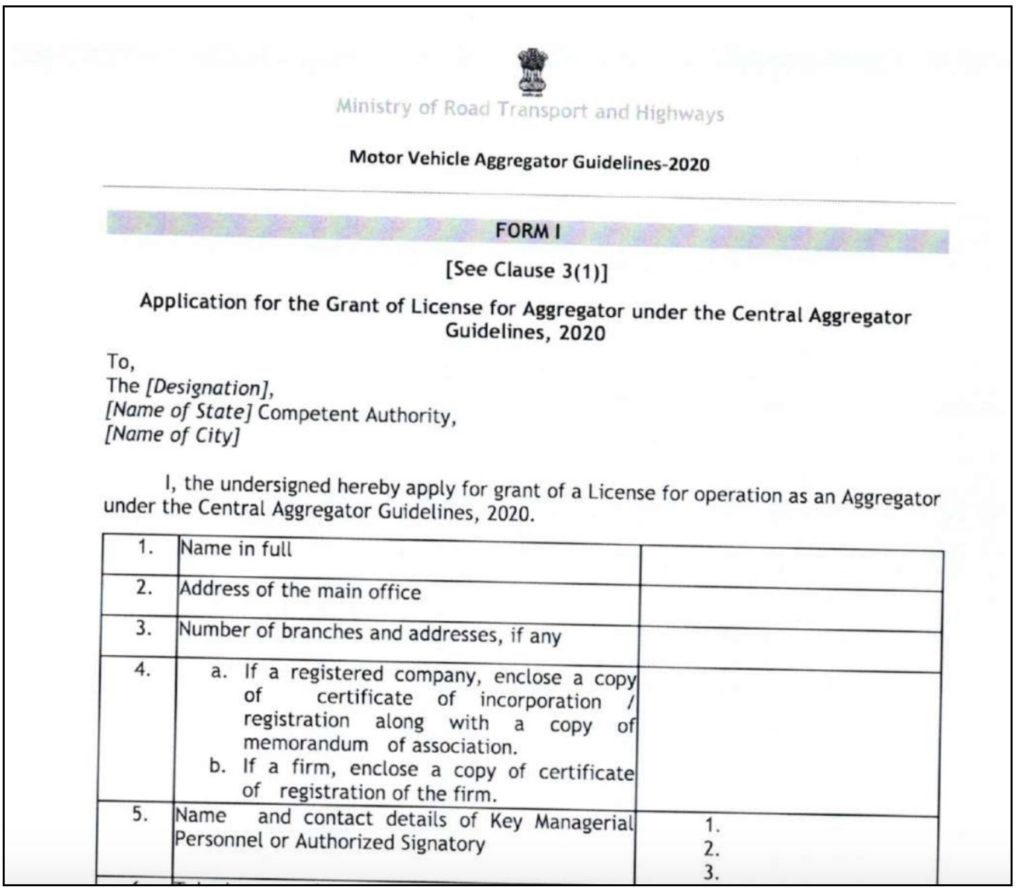
Induction training programmes and testing driving ability are necessary for granting license
Applicants for the aggregator license must arrange for testing the drivers’ driving ability and also conduct an ‘Induction Training Programme’ in which the drivers must be trained to use the aggregator application, be appraised of the provisions and rules of MV Act, road safety and first responder training, careful and fuel efficient driving, vehicle maintenance, health and hygiene, familiarization with routes, gender sensitization and women safety, and terms and conditions of the contract.
Before integrating drivers, aggregators must keep copies of drivers’ valid ID proof, valid driving license, and a KYC compliant bank account details or Jan Dhan account details. They must have a minimum experience of two years or else undertake a driver training. Aggregators should also ensure that the drivers have not been convicted of cognizable offence against them in the last three years. Complete medical check-up and police verification of their identity must also be done.
What about Driver Welfare?
As far as driver welfare is concerned, the guidelines mandate that each driver must be given a health insurance of minimum Rs. 5 Lakhs and a term insurance of Rs. 10 Lakhs with 2020-21 as the base year and with an increase of 5% each year. Annual Refresher Training Programs must also be conducted. Each driver should not be logged in for a total of 12 hours in a calendar day including all aggregators apps they have integrated with. A break of 10 hours is mandatory if they are logged in for 12 hours. Aggregators should have an option for riders to rate the driver’s etiquette, and vice-versa. In case, the driver has ratings below 2 percentiles, then they should undergo a mandatory ‘Remedial Training Programme’.
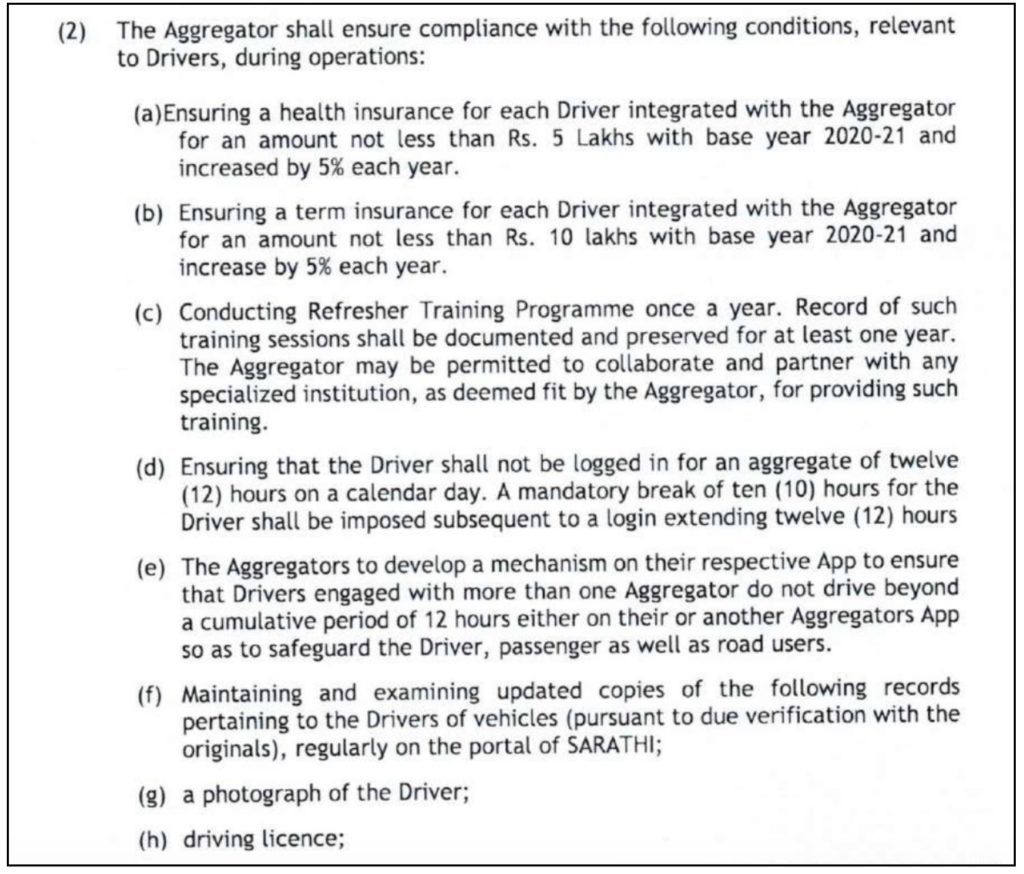
App should be available in English, Hindi, and an official language of the state
With respect to vehicles, the aggregators must have vehicles’ RC, fitness certificate, pollution certificate, permit, chassis and engine numbers, insurance policy papers, and clearance of e-challans. The vehicle must have a fire extinguisher and child lock has to be disabled. Vehicle permit and driving license shall be displayed clearly in the vehicle for the rider. The aggregator’s application (app) should be accessible in one official language of the State (where Hindi is not official language), in addition to English and Hindi.
Data to be stored in Indian Servers
The application’s safety should be certified by a recognized cyber security firm. Data generated must be stored in an Indian server for a duration ranging from 3 to 24 months and be available to State Government. Customer related data can be disclosed only with their written consent. Details pertaining to journey like origin and destination, fare, etc. must be available in the application for the rider and driver for 3 months. The application’s algorithm, fare payable to driver, and other details as necessitated by the state government must be displayed in the aggregator’s application and website. Feature to share live location or status of trip for rider should also be available. Some other details that should be made available for the rider through the app are driver’s photograph, aggregator’s ownership details, registered address, fare structure, consumer services offered, and 24*7 customer care contact details.
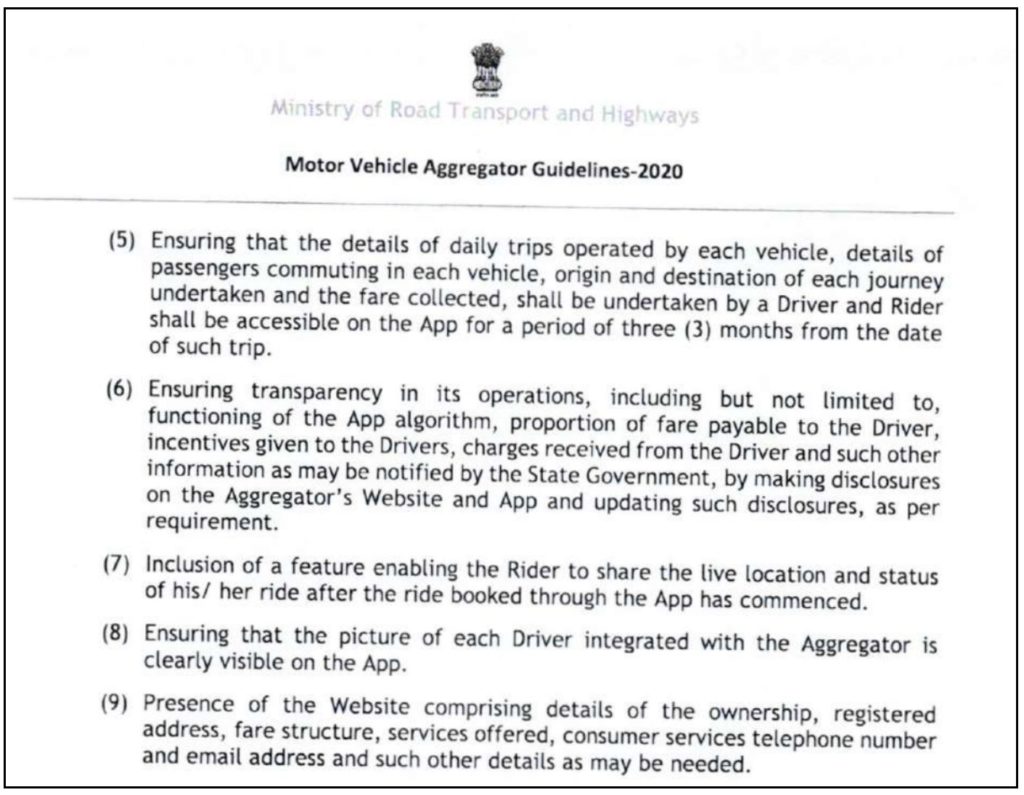
Riders should report concern within 24 hours
A rider should report their concerns within 24 hours from when the ride was availed. In case of criminal offences, the time limit is extended up to 72 hours. To ensure safety, vehicles should be installed with GPS and the drivers should take only those routes assigned on the application. Measures need to be taken by the aggregator to ensure that driver undertaking the trip and the one enlisted with the aggregator are the same.

Pooling allowed in Private Vehicles also
As stated earlier, the guidelines allow for pooling vehicles. Only those riders whose details and KYC are available will be offered pooling. Aggregators have been allowed to offer pooling services in private vehicles. However, only four intra-city rides per day and two inter-city rides per week are allowed. However, such private vehicles have to obtain an insurance of at least Rs. 5 lakhs for the ride-sharers in addition to the owner & driver. Female riders must be provided with the option to pool with only other female passengers.
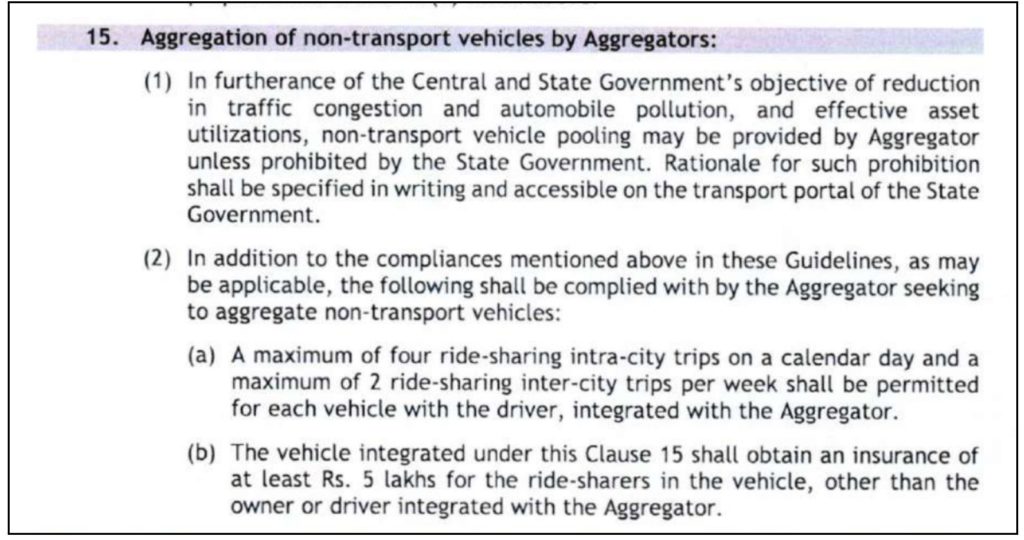
Surge Pricing capped at 1.5 times the base fare
Base fare chargeable to riders will be the city taxi fare indexed by Wholesale Price Index (WPI) for the current year published by the Economic Adviser in the Ministry of Commerce. The minimum chargeable fare is that for 3 kms. In cities which do not have a base taxi fare stipulated, Rs.25/30 will be the base fare. Aggregators are permitted to charge 50% lower than base fare and the maximum surge pricing is capped at 1.5 times the base fare.
The share of fare that the aggregator can receive is capped at 20% and the driver will receive at least 80% of the fare. If a booking is cancelled by a driver without a valid reason, 10% of fare up to Rs. 100 will be imposed. If the rider cancels the booking, similar penalty is imposed which would be shared between the aggregator and driver as 20% and 80%.
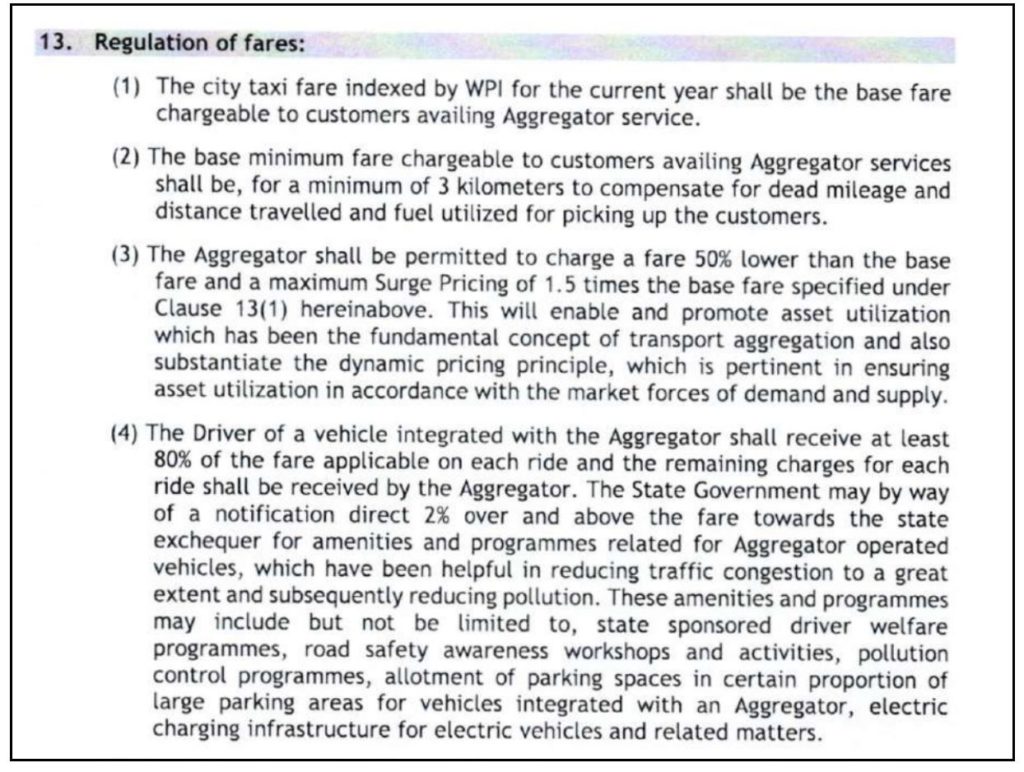
Implementation holds the key
The new guidelines come at a time when there no policy to govern cab aggregators. Few states like Karnataka had come up with rules for such services. Even in July 2019, the Supreme Court had asked the government to frame laws to regulate their functioning especially in terms of women safety, after cases of molestation and theft by cab drivers have been reported across India. Some of the common issues faced by riders such as verification of driver’s identity upon acceptance of ride and grievance redressal have been addressed in the guidelines. Certain provisions like sharing live location and displaying fare are already being implemented by some of the aggregators. However, one has to wait and see for the actual implementation of these guidelines.
Featured Image: Motor Vehicle Aggregator Guidelines


